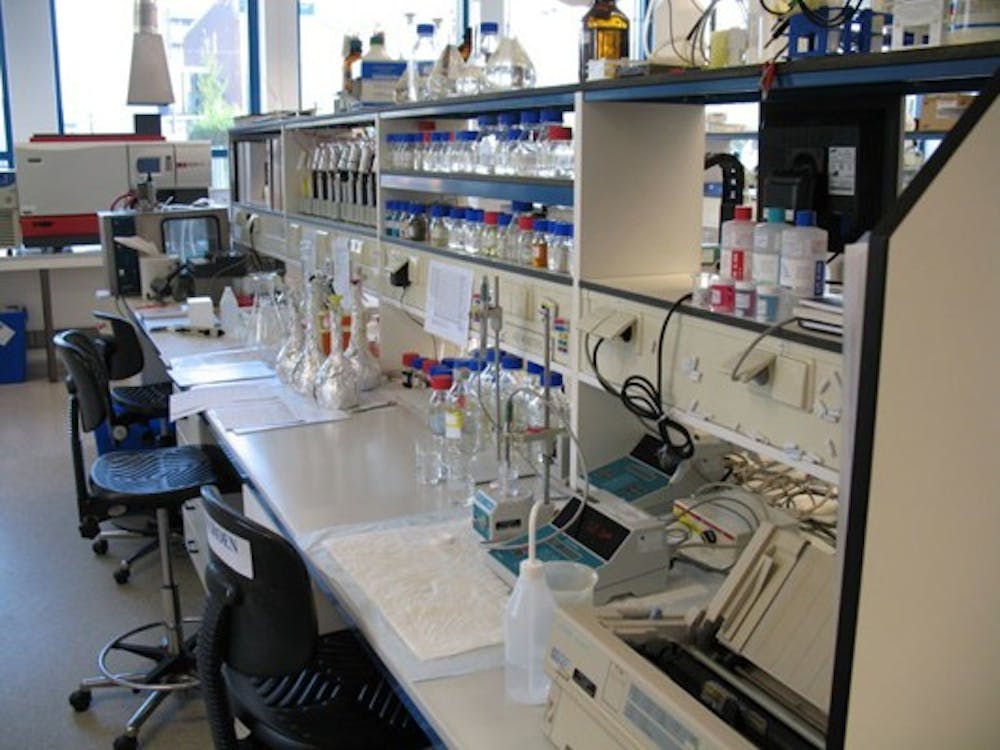Strict university safety regulations train researchers to avoid injuries
Fire, broken glass and chemical burns are just a few hazards facing students working in Central Michigan University’s campus laboratories.
Instructors like Anthony Chappaz, an assistant professor of geochemistry, uphold strict security regulations in the various labs.
“All of these acids can cause severe burns if in contact with the skin,” he said. “You might not feel it right away, but if you don’t clean your hands off, the acid will literally weaken your bones.”
Chappaz’s research focuses on analyzing sediment samples of lakes and oceans to detect trace elements, and dangerous chemicals such as sulfuric and nitric acid are used regularly to “mineralize” his samples.
Many labs work with highly dangerous or flammable substances, so students and faculty must partake in general lab safety training, as well as training led by lab managers across campus.
Each lab employee must also be walked through lab safety training with their supervisor. Training includes learning where fire extinguishers and exits are located, reviewing chemical spills and emergency procedures, and completing standard operating procedures. Once training is complete, a record is kept on file for each employee.
Because of the severe side effects of contact with the chemicals used in his research, Chappaz puts everybody entering his lab through intensive training.
“We have drastic security regulations,” he said, referencing the two-month training session volunteers must complete before beginning work in the lab. “We have signs everywhere that remind people to pay attention to what they’re doing. I have a lab manager who enforces all rules and runs training sessions, and there are emergency kits everywhere just in case something happens.”
Chappaz is not the only professor with such stringent rules.
Professor of physics Valeri Petkov conducts research dealing with the quality of materials used to build every day objects such as chairs, cars and mechanical devices. In his research, those working in the lab are required to use X-ray machines, which require extensive training and precaution.
“In order to work in the lab, everybody goes through a chemical materials safety training,” he said. “This includes online videos and face-to-face instruction. But, since my lab deals with radiation, too, that requires a second training. Additionally, somebody from the state of Michigan comes out every few years to examine equipment and make sure no radiation is leaking out.”
Petkov said his lab, like most others on campus, is fully equipped with emergency kits, hand and eye wash sinks, a full-body shower and a materials safety data sheet, which fully describes each chemical in the lab and how it must be handled.
Recent CMU graduate Tiffany Reinke is no stranger to working with dangerous chemicals and the training that comes with doing research.
The Saint Charles native estimates she has been through about 10 hours of pre-lab training. Reinke spent a summer working in neuroscience program director Gary Dunbar’s lab, using mice to research Alzheimer’s Disease.
The nature of her research required her to go through animal safety, injection, cleaning and radioactivity training sessions. She said the training she received in order to do research helped her in the classroom, too.
“I feel like I was a lot more prepared (for classes) than some other students through doing research for the university,” Reinke said. “I had a lot more training than the other students did, so when I went to the classroom, I had knowledge that other students didn’t.”
Although Chappaz says the general training sessions are essential, he offers the same advice to all students in his lab.
“The number one thing I tell them is to think about what you’re doing to minimize the risk,” he said. “I just want to make sure they are always paying attention”




